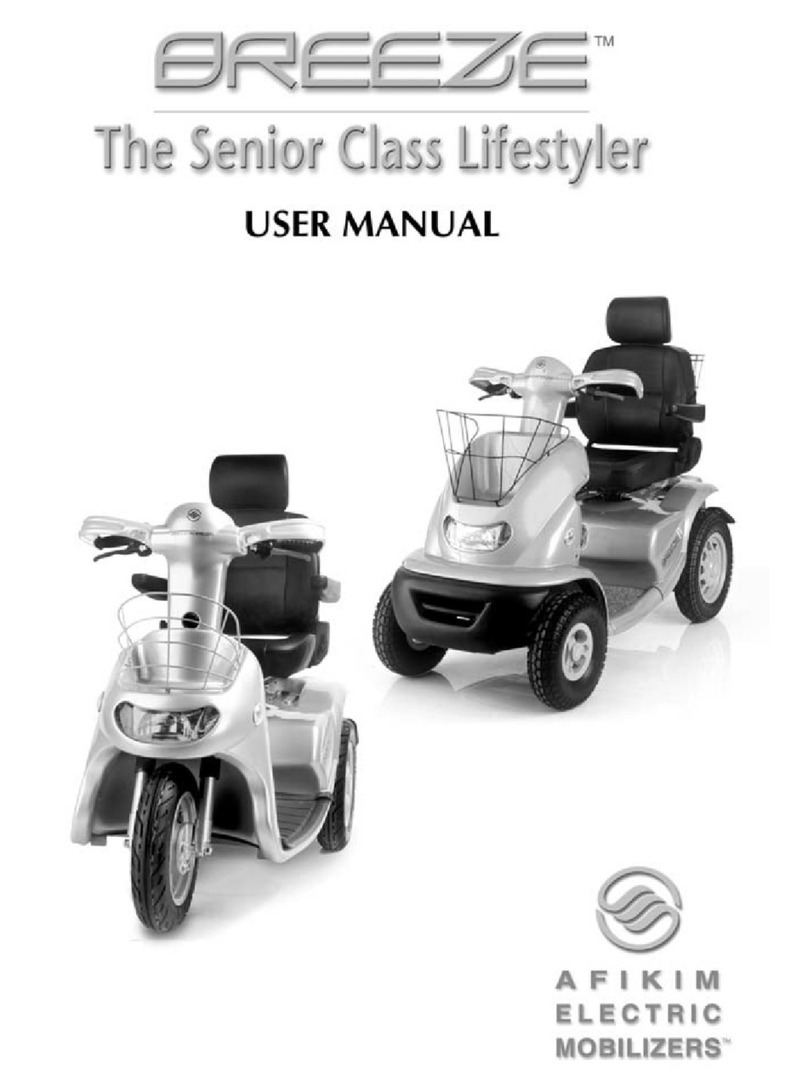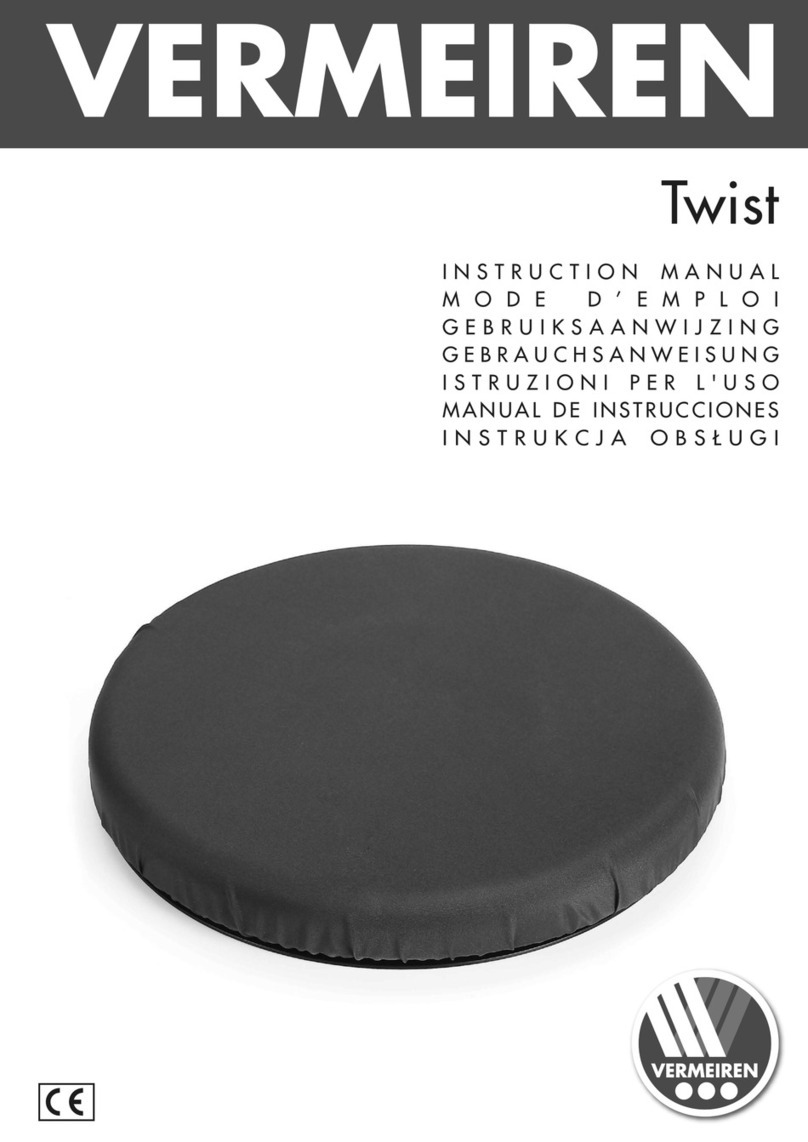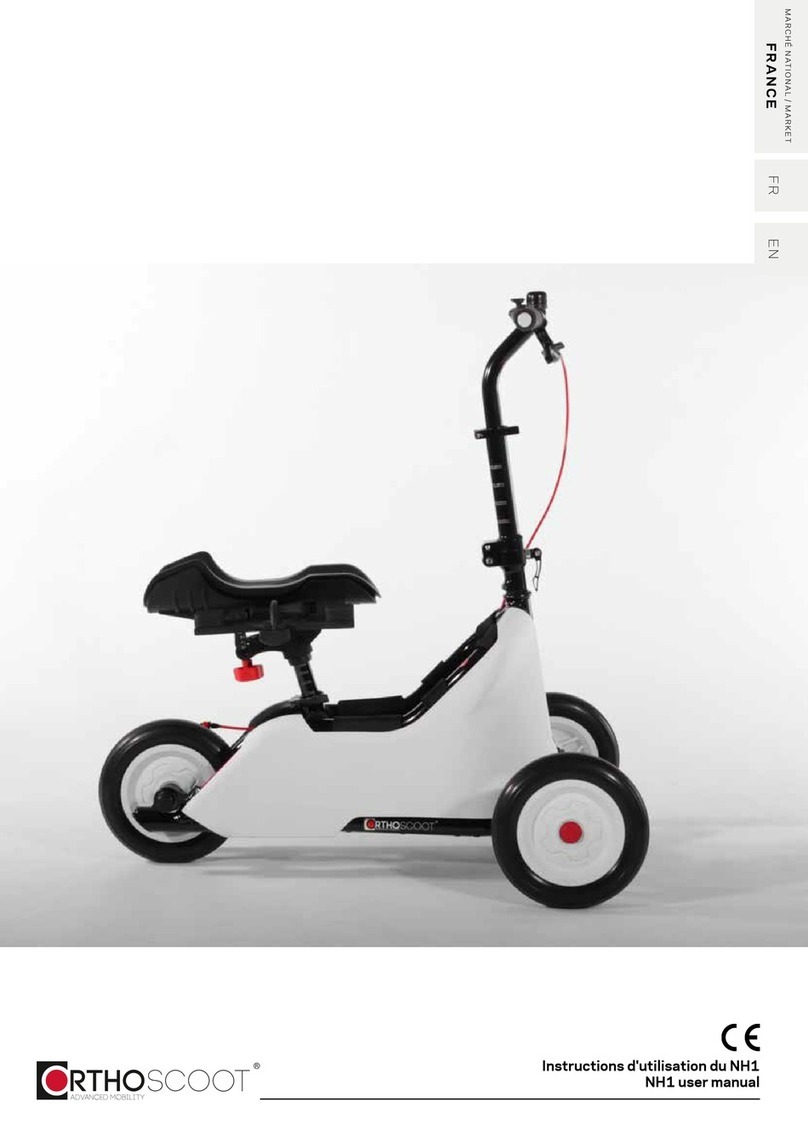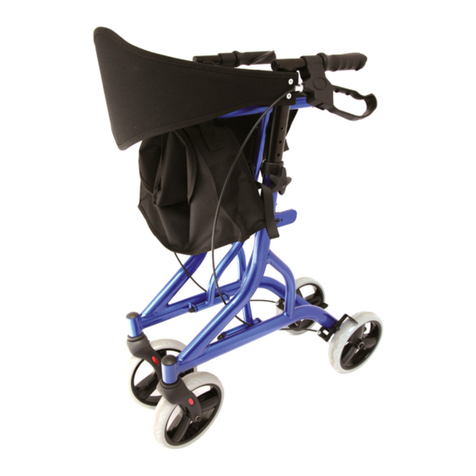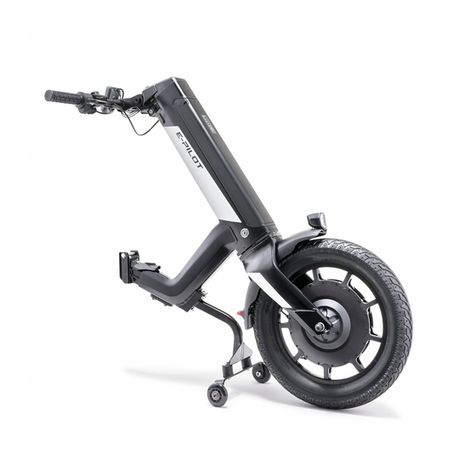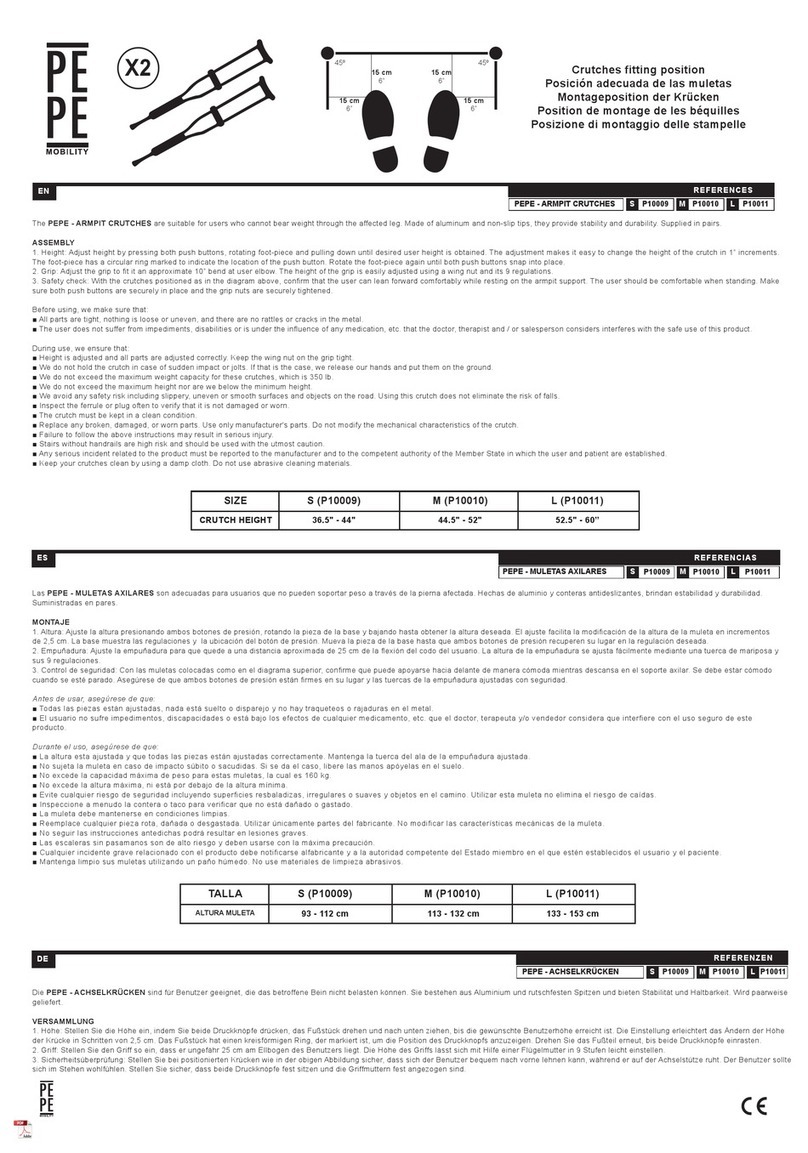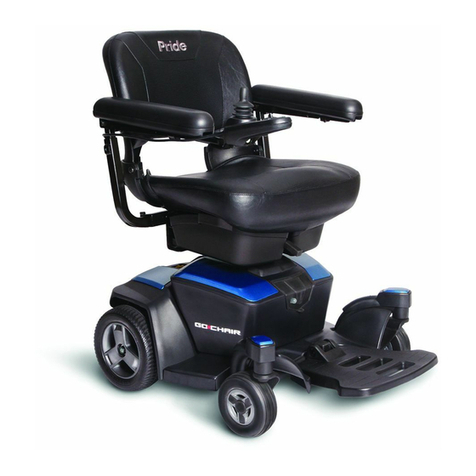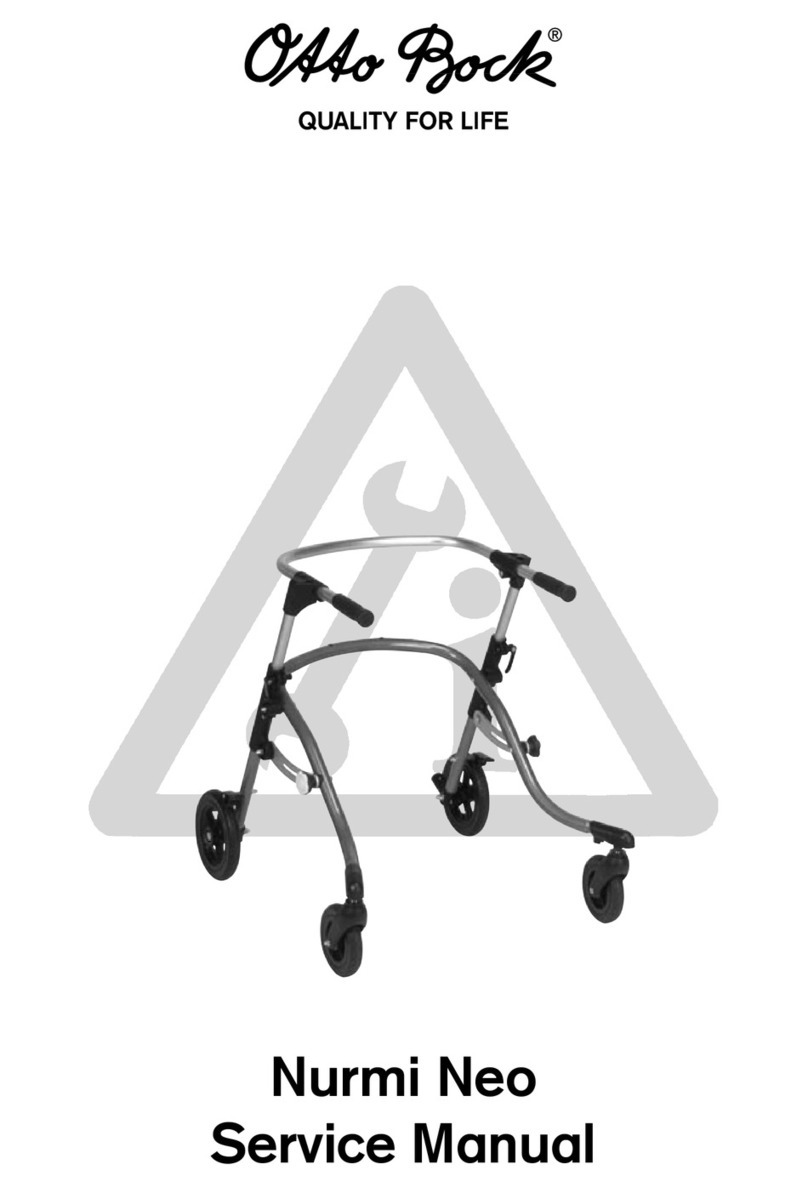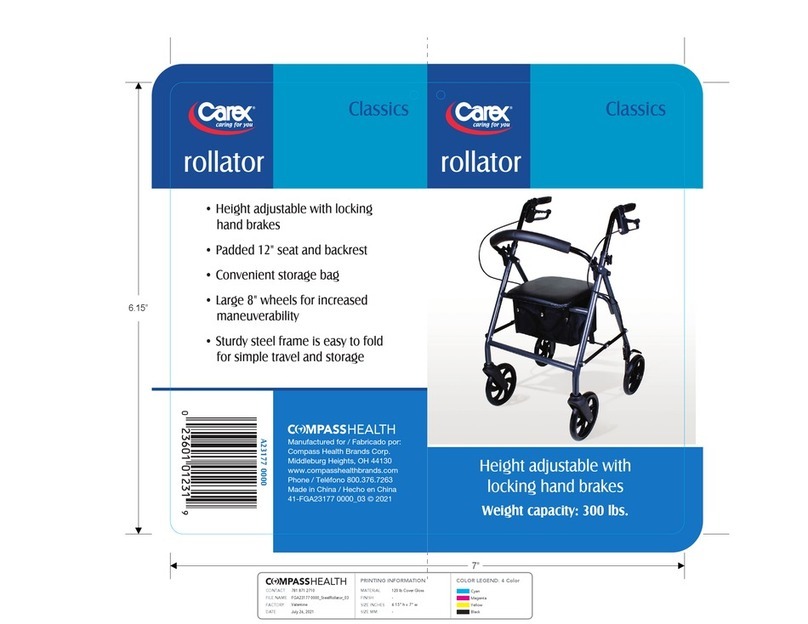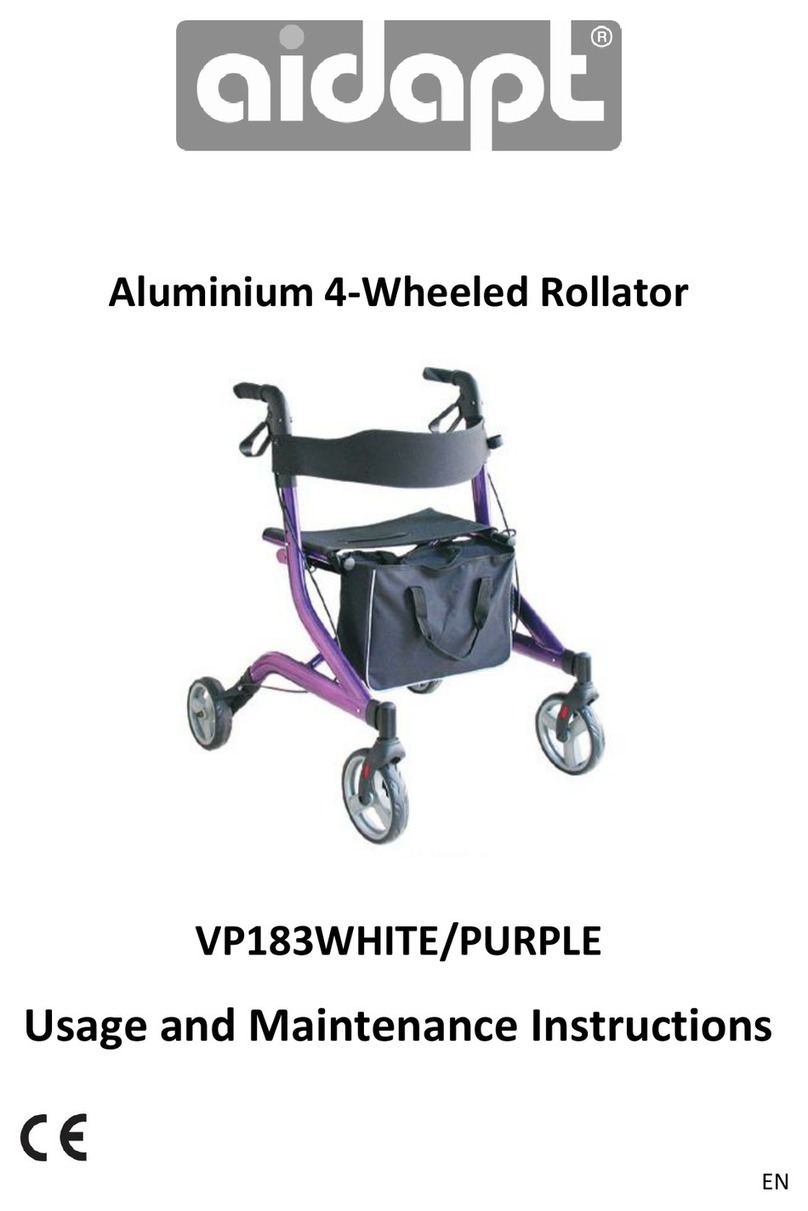Afikim Breeze User manual

-- Revision 3, 18/7/2013 –
\Breeze S\9-------------------------MAINTENACE\3------------SERVICE MANUAL\Service manual Eng\Breeze S - Maintenance Manual -
version 18-7-2013.docx

Contents
1. Safety instructions 3
2. Specific Tools for technicians 4
3. Specific Parts: 4
4. Options / Accessories assembling drawing /instructions 4
5. Mechanical Adjustments 5
6. Front Electronics Board Setup 6
7. LCD Display Set Up and User Manual 7
8. Controller Programming / Setup 11
9. Controller Parameters List 11
10. Periodic maintenance Check 12
11. Mechanical Fault troubleshooting 14
12. Control and Electronics system fault troubleshooting 16
12.1 General control system and Front Board Troubleshoots 16
12.2 Trouble Shoot Table: 16
12.3 Controller / Drive Troubleshoots 17
12.4 Controller Fault codes using the LCD: 17
12.5 Controller Trip codes using programmer SP1 & actions to repair: 18
12.6 Possible Faults symptoms and repair actions: 18
13. Mechanical assembly drawings 19
14. Electrical diagrams - General Wiring diagram 19
20

1. Safety instructions
1.1 General:
1.1.1 Technicians who are servicing the scooter should be authorized to service the
scooter.
1.1.2 Technicians who are servicing the scooter should be aware and follow all safety
instructions within the User Manual.
1.1.3 Technician should follow general safety instruction like using gloves, safety glasses
when needed.
1.1.4 The scooter weight with batteries is about 150 kg even lifting 1 wheel is about 40
kg. Always use other people help or a appropriate lifting device.
1.1.5 When lifting always use your legs and not your back.
1.1.6 The battery weight is about 24 kg . The power unit weight is about 25 kg. The seat
weight is about 15kg.
1.1.7 Never do any change in the product before consulting the manufacturer
engineering. Remember the products are approve as they are , any chage remove
the manufacturer responsibility for the safety of the product.
1.2 Drive :
1.2.1 Technicians who are drivinging the scooter should be aware and follow all safety
instructions within the User Manual.
1.3 Mechanic :
1.3.1 It is possible that a technician will need to operate the scooter when he is standing
on the side ,working on different assemblies.
1.3.2 When no electric power and operation needed , always Stop the power by Switch
OFF and disconnecting the battery terminals.
1.3.3 Never put any part of your body under the scooter parts.
1.3.4 If necessary, first place a wood block under, to make sure no injure will happen.
1.3.5 Use standard tools. Use them according to their safety instructions .
1.4 Electric :
1.4.1 If necessary to operate the scooter when you are not seating on it. In such cases
you should be aware to the parts that can move by power –Power unit shafts and
wheels.
1.4.2 Never put your hands close to a part that is moving or turning. Be aware that your
cloth will not be trapped into one of the moving parts.
1.4.3 Batteries contain a large electric energy inside. This energy can cause sparks and
heat metals when short circuiting.
1.4.4 When working on the battery terminals, make sure no to short circuit between any
2 terminals. This can cause strong spars and make the tools very hot.
1.4.5 When working on the batteries, use protecting gloves and safety glasses.
1.4.6 Battery contains acid. Never open any of the battery case. If you see any liquid or
Gel aside, beware of it. It might be Acid.

2. Specific Tools for technicians
Standard tool box (wrenches, socket-head cap screw , hexagon keys, Phillips
(crosshead) tip and/or screwdrivers, etc.)
Voltmeter (To measure 24VDC)
Air pressure gauge (To measure 35 psi)
Batteries tester (under load)
Density meter
Valve Wrench
Wooden blocks to elevate the Breeze during checks, maintenance and repairs:
2 blocks 20-22 centimeters height to place beneath the batteries box.
2 blocks 14-16 centimeters height to place beneath the foot rest area.
Remark : Always before operating a lifted Breeze make sure that the 2 rear
wheels are free to turn , so that the scooters will not move.
3. Specific Parts:
We recommend the availability of the following set of test and repair assemblies:
1. Handlebars switches –Left and Right
2. Front Board
3. Display LCD Board
4. Main Harnesses Cable.
5. Main Lights Harness Cable.
6. Main Supply Harnesses.
7. Controller SDrive 140A - P&G
8. Motor/Power Unit
9. Also it is very much recommended hold and use P&G SP-1 Programmer (for S-Drive,
possible to upgrade old model to modified free of charge).
4. Options / Accessories assembling drawing /instructions
See attached accessories assembling drawing:
"Breeze S accessories1.pdf"

5. Mechanical Adjustments
#
Description
Where
How to Adjust
1
Seat Height
Seat pin under the battery
cover.
See attached assembling
drawing:
"Breeze S(4W) assembling.pdf"
Release both secure bolt and
level bolt. Change pin Level
hole as required . Resecure
bote level bolt and secure bolt.
Adjustments : 3 x 20 mm.
2
Tiller Height
Tiller bottom adaptor under
the rubber cover.
See attached assembling
drawing :
"Breeze S(4W) assembling.pdf"
Release the secure nut and
screw , adjust height and
resecure again the screw and
the nut.
Adjustments : 40 mm
continues.
3
Rear Shock
absorber Load
Rear Shock absorber under
the battery cover.
See attached assembling
drawing :
"Breeze S(4W) assembling.pdf"
I t is possible to replace the
whole shock absorber for
persons until 120 Kg and
above.
Also it is possible to adjust the
the load rate by changing the
Sprint pretention. 5 stages are
possible :
20% / 40% / 50% / 80% / 100%
Should be fit to user weights:
80 / 100 / 120 / 140 / 160 kg
Remark: The Adjust should fit
the comfort of the user .

6. Front Electronics Board Setup
There are 2 horns in the Breeze S :
One is main Buzzer – external, located at the front of the tiller.
Second is Internal Buzzer located on the front board.
Each one of the Horns can be setup to work in one of the follows
options : Controller alarms,Tiller push button , Reverse alarm ,
Blinkers alarms.
The front board include setup options for the Horn. This can be
done with the dipswitch DSW1 that is on the front board.
Dip Switches Setup is as follows : (Shown the Default Set Up)

7. LCD Display Set Up and User Manual
a. LCD Display:
Push buttons:
b. Right –Mode : Use to change between different display modes and to
Reset the Distance and Time.
Every push - changes the display mode cyclic (Speed ,Trip Distance
,Trip Time , Clock). Return automatically to initial (Speed) after 5
seconds.
Long Push - (more than 7 seconds) when change Modes:
Trip Time : Reset Trip time.
Trip Distance : Reset Trip Distance.
Time : Enter to Clock setup.
c. Left- Setup : Use to adjust the clock.

d. Internal LED: Use for a technician. Can be seen only from the bottom
side of the LCD board. When LCD board active –flashes to indicate
OK.
e. Display Legend:
Signal Direction - Use to show Blinkers working.
Main Light - Use to show Front lights and rear Pilot lights are working.
Digital information - Shows : Speed ,Distance of Trip ,Time of Trip,
Time or Faults Codes.
Speed Units –Show mph(miles per hour) or kph (kilometers per hour).
Distance Units- Shows: mile (miles) or km (kilometers).
Time –Shows Hour = HH:mm (hours:minuts).
Half Speed –shows 1 (full) or 1/2 (half speed)
Battery Capacity –8 Bars =full , 1 bar = empty, between is
proportional.
Also flashes at a CODE when there is a controller fault
CODE.
Warning / Inhibit - Indicate when the motor is heated , and when the
EMB is opened.
Dip Switches:
f. #1-2-5: User Modes setup with relate to user needs.
State
Description
"0" = On - On - On
Regular (Speed,Distance,Time ,Clock)
"1" = Off - On - On
Minimal (No Digital Information)
"2" = On - Off - On
Speed only
"3" = On - Off - Off
Speed and Distance only.
"4" = On - On - Off
Hour only.

g. #3: Controller Type setup –
State
Description
Remark
Off
PG SDrive
Battery status from Controller
On
Dynamic Rhino
Battery status calculated upon
Algorithm (22-24 VDC)
h. #4: Units setup (Europe or US)
State
Speed
Distance
Date (in Clock mode)
Off = Europe
kmh
km
DD.MM
On = USA
mph
mile
MM.DD
i. #6: Pulses per km
State
curve
product
Off
740 pulse / km
Breeze S = wheel diameter = 430 mm
On
1044 pulses / km
Breeze C = wheel diameter = 305 mm
j. Clock Adjust:
Every push on Mode change different time unit and this unit is
Flashing.
When Flashing , every push on Setup increase 1 unit.
Stage
Display
Flashing
1
HH:mm
mm
2
HH:mm
HH
3
DD.MM
or
MM.DD
DD
4
DD.MM
or
MM.DD
MM
5
20YY
YY

6
Save of Updated Time and Date
k. Controller Fault Code : will be shown together with Speed ,changed
every 2 seconds.
"Er xx" , xx= Code known by the controller.
"Bat x", x= Battery Codes 1-3.
Will be shown on Batt. Icon upon controller fault code.
l. Technician state : active when Mode button is pressed :
(a) Will show software version, before it returns to regular work mode.
(b)LED will flash constant until the LCD board is OFF.
Note: it needs a complete OFF , not only Power signal change.

8. Controller Programming / Setup
If the user cannot find a position on the half speed limit switch
control that suits him, the controller can be programmed to meet
his needs. The controller can be programmed in two ways –with
an SP1 Programmer or specialist PC software and interface
cable.
The SP1 is a small hand-held unit which can be plugged into
your controller to alter the program.
The PC Programmer is a piece of PC software and an interface
cable. When the software is installed onto a PC, it can then be
connected to the controller by using the special interface cable.
The controller can then be programmed using a windows type
environment
The programming tools may be included with your scooter. If
they are not, the scooter distributor or service agent or scooter
manufacturer will are able to program the controller.
If you have a programmer, read the user guide before you use it.
If you re-program your controller, make sure that you observe
any restrictions given in your scooter user manual. Note any
changes you make for future reference.
Programming should only be conducted by healthcare
professionals with in-depth knowledge of PGDT electronic
controllers. Incorrect programming could result in an unsafe
set-up of a scooter for a user. PGDT accept no liability for
losses of any kind if the programming of the controller is
altered from factory pre-set values.
9. Controller Parameters List
See external separated file.

10. Periodic maintenance Check
No.
Type of Service
Who
Frequency
1
Check air pressure in
all tires.
User
Every week
2
Check emergency
brakes
User
Every week
3
Check normal drive and
stop
User
Every Month
4
Check tires wear
User
Every Month
5
Check for missing parts
and damaged parts
.Use the figures
#1,2,3,4 .
User
When receiving the Breeze S or after a long
time not using it.
6
Check emergency
brake
User
Every Month
7
Check secure of all
screws and parts
Technician
Once a year by technician.
8
Batteries replacing.
Technician
Every 2-3 years , after about 300-400 full cycles
of charge/discharge. When short travel distance
and/or technician check.
Note: To Replace the batteries, the Seat and
Battery Cover located under the Seat must
be removed.
9
Cleaning
User
Technician
External –when needed.
Internal –Once a year.
10
Check power unit
Technician
Check noise , clearance , current on surface
should be 12 to 15 Amp.
11
Check Emergency
Brake
Technician
Once a year.

Periodic maintenance - continue
Removing the Seat and the
Batteries Cover(2)
Turn the Seat by using the lifting Lever (7.5) so that the
Lever will point 45º Right or Left. The Seat can be
removed only at this position.
Remove the Seat (7): Hold the Seat in your two hands
–one hand on the backrest and a second hand at the
front lower part of the seat and lift the seat up from its
pivot.
Warning! The seat weight is 15 Kg (33lbs).
Keep lifting with your Knees/legs and not loading your
Back. Release Battery Cover (2) securing screws (2.6).
Lift the Battery Cover (2) until it is released from the
Seat Pivot .
Replacing the Batteries Cover(2)
The replacement of the Gray Cover is done in reverse
order; MAKE SURE that the Gray Cover (2) fits onto
it’s place. Secure with the 4 screws (2.6).
Batteries
Batteries weight each ~23 Kg (~50 lbs) and over.
Lift each battery only with the appropriate handle. Keep
lifting with your Knees/legs and not loading your Back.
Tires
Correct air pressure in the tires is essential for optimal
steering and stability of the Breeze S. Check air
pressure every two weeks.
Inflate to the proper air pressure: 25 ±2 psi. Breeze 4W
front tires: 20±2 psi. Golf wheels tires : 20±2 psi.
Cleaning
Use only a damp cloth and mild detergent. Never use a
hose for cleaning. This may severely damage the
power and electronic components.

11. Mechanical Fault troubleshooting
#
Description
Probable cause
Repair action
1
Noises from front
steering and
suspension
system
Check front suspension for
clearances and secure of bolts.
Check front shock absorbers.
Replace wear parts,
secure bolts.
Replace if needed.
2
Front suspension
not functioning
properly.
Check front shock absorbers.
Replace if needed.
3
Excessive wear of
front tires after
short period.
Wear of bushings that cause
clearances in the system.
Un adjusted steering system.
Replace wear parts ,
Adjust the steering
and secure.
4
Rear suspension
Noisy.
Wear in power unit absorbing
Rubbers.
Check for clearances and
unsecured parts.
Check the shock absorbers.
Replace the
absorbing rubbers if
needed.
Secure parts.
Replace shock
absorbers if needed.
5
Rear suspension
not functioning
Check user weight and the fit of
the absorbers.
Faulty shock absorbers
Replace if needed
Replace if needed
6
Noise from power
unit.
Wear in power unit
Check and replace
power unit if needed
7
Too short distance
travel between
charging
Power unit wear, consume high
current. Also might be noisy.
Check noise and
current and replace
if needed.
8
Clearances in tiller
Unsecured screws and gas
piston faulty
Check scure of
screws.
Replace gas piston if
needed.
9
Scooter does not
have power or
does not brake
Wear in motor brushes.
Replace motor
brushes.

well or go to high
speed downhill.
10
Noises from motor
Wear of brushes.
Faulty motor.
Check brushes and
replace if needed.
Replace motor.
11
Emergency
handbrake does
not stop
The brake cable is not tight or
brake drum/disk is wear.
Tight cable and
replace brake
drum/disk if needed.
12
Flat tire and
uneven and not
smooth drive
Flat tire
Repair / replace
tire's tube.

12. Control and Electronics system fault troubleshooting
12.1 General control system and Front Board Troubleshoots
The front board is the center of all peripheral functions of the scooter : Lights , Horn ,
Information goes to the LCD display .
Elimination troubleshoots:
The Front Board wiring connections are all quick connectors.
If you suspect the Front Board to be faulted we recommend as a quickest way to find if the
Front Board is faulty, Doing by elimination –Just replace temporarily the Front Board with
another working one and thus make sure if the problem is within the Front Board or
somewhere else.
Check all connection of the Front Board, following the wiring diagram that can be found within
this maintenance manual.
Check main and Charging fuses, located near the rear wheels.
Also always check related function switch , as example Light does not work , first check the
light switch for continuity ,when is in ON position. Use the wiring diagram to figure the proper
terminals to check each function switch terminals.
12.2 Trouble Shoot Table:
#
Description
Probable cause
Repair action
1
First check that Front Board
internal LED flashes. If it is not
Flashing.
Front Board is faulty or
no power supply to the
board.
Check Supply. If OK than
Front Board is Faulty –
Replace it.
2
If LCD is not working, check if
LCD internal LED flashes. If it
is not flashing.
LCD board is faulty or no
power supply to the
board.
Check supply. If OK than
LCD board is faulty –
Replace it.
3
Front light doesn't work
Front LED board faulty
Replace front LED board
Front Board faulty
Replace Frond Board
4
Front Blinker/s doesn't work
Front Blinker board faulty
Replace front Blinker board
Front Board faulty
Replace Frond Board
5
Rear pilot/s light does work
Rear Blinker board faulty
Replace Rear Blinker board
Front Board faulty
Replace Frond Board
6
Rear Blinker/s doesn't work
Rear Blinker board faulty
Replace Rear Blinker board
Front Board faulty
Replace Frond Board
7
Horn does not work properly
External Horn is faulty
Replace Horn
Internal Horn is faulty
Replace Frond Board
Front Board faulty
Replace Frond Board
8
Hazard doesn't work
Hazard switch fault
Check switch and repair
Front Board faulty
Replace Frond Board
9
Reverse function doesn't work
Reverse switch fault
Check switch and repair
Front Board faulty
Replace Frond Board
10
Electric EMB release function
does not work
EMB release Switch
faulty
Check switch and repair
Front Board faulty
Replace Frond Board
11
LCD is not powered ON
LCD board faulty
Replace LCD board
Front Board faulty
Replace Frond Board
12
No Charge start
Charger fault
Replace charger
Charge fuse popup or
faulty
Reset /Replace charge
fuse
13
Travel distance very low
Charger fault
Replace charger
Old / Weak batteries
Check Batteries / charge
batteries, Replace if

needed.
14
The LCD does not keep the
time
LCD battery end of life
(after 3-5 years of use)
Replace the LCD Battery.
15
No power or main fuse pop out
Over load
Mechanical fault
Fault controller
Faulty power unit
Short circuit occur
Try to reset 2 times.
Troubleshoot the fault.
Replace the controller.
Replace the power unit.
Find and repair short
circuit.
12.3 Controller / Drive Troubleshoots
The controller is the center of all driving functions of the Breeze S: Speed control ,
acceleration , deceleration , EMB (Electro Magnetic Brake used as parking brake) , Reverse
drive , Speed limiting etc. . But still the functions of the controller are all connected to all the
wiring, connectors and as well the Front board, power units and batteries.
Elimination troubleshoots:
The controller wiring connections are all quick connectors.
If you suspect the controller to be faulted we recommend as a quickest and way to find if the
controller is faulty, Doing it by elimination –Just replace temporarily the controller with
another working one and thus make sure if the problem is within the controller or somewhere
else.
Check all connection of the controller, following the wiring diagram that can be found within
this maintenance manual.
12.4 Controller Fault codes using the LCD:
Count the number of flashes in the battery indicator of the LCD and see the code in the
follows Table (Each cycle there is a short stop of few seconds):

12.5 Controller Trip codes using programmer SP1 & actions to repair:
When the fault exists, connect the SP1 programmer's connector directly to the controller
SDRIVE140 or to the charging socket, using a special wiring adaptor.
Trip
Code
Action
A01
Quick switch ON / OFF. Switch OFF wait few seconds and ON again.
Possible fault of main key-switch. If hundreds time suspect the keyswitch.
0300
Check the tiller & throttle wiring to the controller, then retest
0815
Check the tiller & throttle wiring to the controller, then retest
0A00
Check the sleep mode parameter is set correctly, then retest
0E07
Check the tiller & throttle wiring to the controller, then retest
0E08
Check the tiller & throttle wiring to the controller, then retest
1501
Check the solenoid brake’s wiring & connections to the controller, then retest
1502
Check the solenoid brake’s wiring & connections to the controller, then retest
1600
Check the batteries’ wiring & connections to the controller, then retest
Possible high voltage due to high load downhill. Possible to decrease the half speed parameter
to 40% and instruct the user to drive 1/2 speed mode down-hills.
1601
Check the batteries’ wiring & connections to the controller, then retest
1705
Internal faults in relay.
1E08
Check the wiring & connections to pin 4 of the programming socket, then retest
1E09
Check the wiring & connections to pin 6 of the 14 way tiller connector, then retest
1E0A
Check the wiring & connections to pin 14 of the 14 way tiller connector, then retest
2C00
Check the batteries’ wiring & connections to the controller, then retest
2F01
Check the throttle is not displaced on start-up, then retest
2F01
Check the tiller & throttle wiring to the controller, then retest
3100
Battery connected whilst scooter is switched on. Turn off, wait 10 seconds, then retest
3B01
Check the motor wiring & the connections to the controller, then retest
3D02
Check the motor wiring & the connections to the controller, then retest
3D03
Check the motor wiring & the connections to the controller, then retest
3600
Internal un expected fault in the controller
4401
Internal controller fault
5300
Programmable parameter changed. Turn the scooter off, then on again, then retest
7000
Push at startup
7001
Push at drive
7C00
High temperature in the controller.
1E09
Inhibit activated.
Can be caused by the electromagnetic brake lever micro switch or panic sensor.
All
Others
Check all wiring & connections to the controller, then retest. Try replacing the controller.
12.6 Possible Faults symptoms and repair actions:
Symptom
Action
No power to programmer
Check the wiring & connections to the batteries, then retest
No power to programmer
Check the wiring & connections to the programmer, then retest
Scooter drives slowly
Check the controller is programmed correctly, then retest
Scooter drives slowly
Check the speed limiting function is not active e.g. seat raised,then retest
Scooter drives slowly
Check the solenoid brakes are not jammed, then retest
Status indicator does not light
Check the wiring & connections to the status indicator, then retest
Reverse alarm does not sound
Check the wiring & connections to the buzzer then retest
Reverse alarm does not sound
Check the buzzer is working correctly, then retest
Reverse alarm does not sound
Check the scooter is programmed correctly then retest
Scooter will not drive in reverse
Check the tiller wiring & connections, then retest
Scooter will not drive in reverse
Check the reverse switch is working correctly, then retest
In cases that the scooter with
transaxle 12 km/hr is recoil.
Reduce the compensation parameter from 50 to 40.

Slow or Sluggish Movement
If the scooter does not travel at full speed and the battery condition is good, check the
position of the speed limiting control. If adjusting the speed limiting control does not remedy
the problem then there may be a non-hazardous fault.
Contact your service agent.
User Daily Checks
Throttle: With the scooter switched off, check that the throttle mechanism is not bent or
damaged and that it returns to the position when you push and release it. If there is a
problem do not continue with the safety checks and contact your service agent.
User Weekly Checks
Throttle: Put the throttle to the full speed forward position and switch the scooter on. The
scooter should not move. show you that you have switched the scooter on with the throttle
already pushed, a True Charge Trip type status indicator will display 7 Bars, whereas a single
bulb (or LED) type status indicator will flash seven times sequence.
If the scooter does move, contact your service agent.
Parking brake: This test should be carried out on a level surface with at least one meter clear
space around the scooter.
Switch the scooter on.
Check that the status indicator remains on, or flashes slowly, after half a second.
Go to drive the scooter slowly in the forwards direction until you hear the parking brake
operate. The scooter may start to move.
Immediately release the throttle. You must be able to hear the parking brake operate within a
few seconds.
Repeat the test in the reverse direction.
Cables and connectors:
Check that all connectors on the scooter are securely mated, and ensure that all cables are
free from damage.
13. Mechanical assembly drawings
See attached assembling drawings: Breeze S (4W & 3W) assembling.
14. Electrical diagrams - General Wiring diagram

Other manuals for Breeze
2
Table of contents
Other Afikim Mobility Aid manuals

